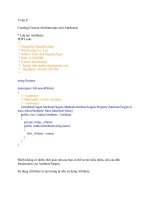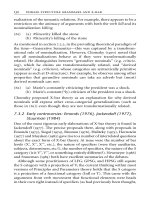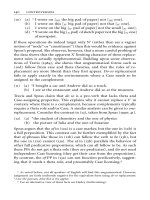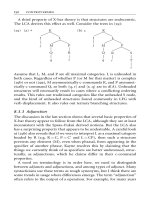Tài liệu Constituent Structure - Part 20 docx
Bạn đang xem bản rút gọn của tài liệu. Xem và tải ngay bản đầy đủ của tài liệu tại đây (104.15 KB, 10 trang )
‘‘object’’. Some approaches such as Dependency Grammar, Role
and Reference Grammar, and Case grammar use basic semantic or
thematic relations (such as agent, theme etc) to a greater or lesser
degree. A more reWned view is found in the type-logical theories such
as Categorial Grammar and HPSG. In these approaches the driving
force is the notion of a functional application or predication. Essen-
tially this boils down to the idea that many individual syntactic objects
are ‘‘incomplete’’ and require an argument to Xesh out their syntactic
and semantic requirements. Take for example an intransitive verb like
leave. Such a verb has simultaneously the semantic requirement that it
needs a entity to serve as the subject, and the syntactic requirement
that that entity be represented by an NP. Other syntactic objects (such
as the NP John, which presumably represents an entity), serve to
complete these requirements. The operations involved here are
variously referred to as uniWcation, feature satisfaction, functional
application, or feature checking.
The last type of variation lies in the means of syntactic representation
of the dependency or relation; that is, the nature of the representation
that is formed by the semantic or semantico-syntactic relationships.
A wide variety of accounts of word order and constituency can be
found. As we will see below, Relational Grammar (and to a degree its
successor, Arc-Pair Grammar) mapped grammatical relations onto
syntactic templates. Closely related are the constructions or schemas
found in Construction Grammar, Cognitive Grammar, and, to a lesser
degree, some versions of HPSG. HPSG and Categorial Grammar use
tree or tree-like structures. But in fact, as we will see these are meant
as proofs that the semantics/syntactic structure of the whole can
be derived from the parts, rather than direct syntactic constituent
representations. As mentioned brieXyinChapter5, LFG uses a series
of mapping principles encoded into ‘‘metavariables’’ that allow a cor-
respondence between the constituent structure and the semantic
form. A similar, although distinct, approach is found in RRG. Finally,
we have theories such as Dependency Grammar and Word Grammar
that use dependency trees (stemma) and related notations (such as
networks).
This chapter is devoted to looking at these alternatives to strict
constituency-based approaches to syntactic structure. Needless to say,
these diVerent topics are tightly interconnected, so I will attempt to
provide the relevant parts of each theoretical approach as a whole in
turn. I start out with Lexical-Functional Grammar and Relational
170 controversies
Grammar which are to a greater and lesser degree based on the
primitive notions of subject and object. Next I turn to the more liberal
class of dependency grammars, where semantic relations are viewed to
determine constituent structure. Next we return the more formal
categorial grammars, which express dependencies through categorial
requirements. We extend this approach to survey Tree-Adjoining
Grammar (TAG), which, although arboreal, builds upon the basic
insights of categorial grammar. Then we consider two functionalist
frameworks of grammar (Dik’s functionalist grammar and Van Valin’s
Role and Reference Grammar (RRG)). Finally, we turn to construction-
and cognitive-grammar approaches, where instead of constituent trees
we simply have templatic constructions or schemata, into which words
are mapped.
There are so many interrelated and intertwined questions here that
teasing out the empirical arguments that favor one approach over
another is very diYcult. To a large extent I will remain agnostic about
these approaches, but will try to point out their particular advantages or
disadvantages as we go along. The reader is warned that the discussion
in this chapter may be inconsistent both with other parts of this book
and internally to this chapter itself. They should also be aware that the
surveys presented here are largely based on the single question of
the nature of phrase structure representations in these approaches, so
the reader shouldn’t judge these frameworks on that criteria alone,
there is much more to each of them than is presented in a couple of
paragraphs in this chapter.
9.2 Systems based primarily on grammatical relations
A number of approaches to grammar consider the primacy of gram-
matical relations, such as subject and object (see Farrell 2005 for an
introduction to these relations and their representation in various
grammatical frameworks).
9.2.1 A Semi-arboreal system: Lexical-Functional Grammar
Strictly speaking, Lexical-Functional Grammar does not belong in this
chapter, because it posits separate constituent and relational structures
(c- and f-structures); but I include it here because of the primacy it places
on grammatical functions (relations). As discussed in Chapter 6,LFG
makes use of a structured representation of grammatical functions, as
dependency and constituency 171
shown in (2). These f-structures are mapped to the constituent structure
(c-structure) using metafunctions and functional equations.
()
PRED
‘love <
SUBJ, OBJ
>’
TENSE
present
SUBJ DEF
+
NUM
sng
PRED
‘professor’
OBJ
[
PRED
‘phonology’]
Among the arguments for an independent functional structure is the idea
that diVerent elements in the constituent structure can contribute to a
single f-structure unit. Take the following example, which is taken dir-
ectly from Falk (2001). The plurality of the subject in the following
sentences is realized in the auxiliary, whereas the deWniteness and the
semantic content come from the NP element. There is no single con-
stituent contributing all the information about the nature of the subject.
(3) (a) The deer are dancing.
(b) The deer is dancing.
This suggests that a separate component is required for semantico-
syntactic relations, which, although mapped to the c-structure, is
independent of it. See Baker (2001a, b) for an attempt to show that a
structurally derived notion of relation is more explanatory for non-
conWgurational languages.
9.2.2 Relational Grammar
We begin our survey of purely derived-constituency or dependent-
constituency approaches by looking at a theory that was at its height
in the late 1970sandearly1980s: Relational Grammar (RG). Later
versions of this theory are known as Arc-Pair Grammar. The basic
premise of RG is that grammatical relations such as subject (notated
as 1), object (2), indirect object (3), predicate (P) and a special kind of
adjunct known as a ‘‘cho
ˆ
meur’’ (cho
ˆ
) are the primitives of the grammar.
Various kinds of grammatical operation apply to these primitive rela-
tions. For example, passive is seen as the promotion of an object to the
subjectroleandthedemotionofthesubjectroletothecho
ˆ
meur role.
This is represented by one of two diVerent styles of relational diagram—
172 controversies
the most common of which is shown in (2). This is a representation
of the passive The puppy was kissed by the policeman.TheWrst line
represents the underlying roles in the sentence, the second line repre-
sents the Wnal form. Word order is irrelevant in these diagrams.
() initial stratum P
final stratum P chô
kissed policeman pupp
y
Word order is handled by mapping the roles to templates. The
declarative template for English is 1 P 23cho
ˆ
, the Wnal stratum is
mapped to this order so that the subject comes Wrst, then the predicate,
then in order the object, indirect object, and any cho
ˆ
meurs.
Templates are a kind of construction grammar. That is, there is a set
of templates associated with particular types of construction. For
example, a wh-object question would be associated with a 2 aux 1 P 2
3 template.
Many of the insights of RG have been subsequently adapted by other
theoretical approaches. For example, the discovery of the unaccusative
class of verbs has been particularly inXuential. GB theory borrowed the
results of Relational Grammar, coding the eVects into the Case module.
The signiWcant diVerence between RG and GB is that GB associates the
particular relations with particular positions in the tree rather than
using a template (e.g. Nominative case corresponds to the 1 relation,
and it is tied to the speciWer of IP or TP; promotion is viewed as
movement).
Baker (2001a) addresses the question of whether relational notions
are best represented as primitives or as part of the phrase structure.
He suggests that RG and LFG distinguish at least two kinds of prom-
inence: relational and embedding. Relational prominence is reXected
in the number of Relational Grammar: 1 is more prominent than 2,
etc. These relations are clause bound. Embedding prominence ex-
presses the idea that some phrases are higher in the tree or complex
relational diagram than others and includes relationships between
argument structures in diVerent clauses. RG and LFG distinguish
these types of prominence; Chomskyan grammar does not: it sub-
sumes them under the c-command relation. In a constituency-based
dependency and constituency 173
theory, subjects naturally c-command objects, deriving the argument
hierarchy. To see a case where grammar treats two diVerent argument
positions diVerently, consider the case of objects and embedded sub-
jects. As Baker argues, RG distinguishes between these two. The em-
bedded subject is a 1 in a structurally embedded relational network, the
other is a 2 in the same set of arcs as the main subject:
()
(a)
P
said John
P
loved Mary beef waffles
(b) P
loves John Mar
y
By contrast, in Chomskyan grammar the two have at least one identical
property, they are both related to the matrix subject by the c-command
relation. Mary in both sentences is c-commanded by John. RG predicts
then that these two positions should not be targeted uniformly by
grammatical rules. Baker convincingly shows that this is not true. The
subject of an embedded clause (the c and d examples) and the object of
a main clause (the a and b examples) are subject to the same restric-
tions on bound variable anaphora (4) and Condition C eVects (5) (all
data taken from Baker (2001a: 37–8). Baker gives related evidence from
Reciprocal binding, Superiority eVects, Negative Polarity licensing,
including cross-linguistic evidence. Facts like these point away from
distinguishing between clause-internal relational prominence and
cross-clausal embedding prominence:
(4) (a) Every boy persuaded his mother that video games are good
for you.
(b) *Her son persuaded every woman that video games are good
for you.
(c) Every boy persuaded the principal that his mother sang
professionally.
174 controversies









